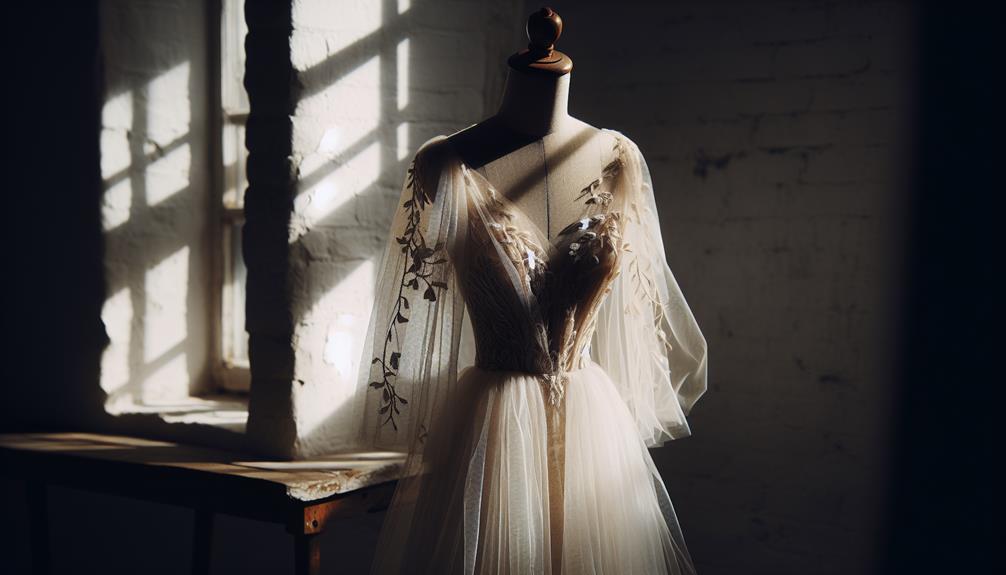I've found that organza's longevity really depends on the material it's made from. While silk organza isn't very tear-resistant, its synthetic counterparts like polyester and nylon are much tougher. The weave and how you treat the fabric also play huge roles in how long it'll last. If you're gentle with it, avoiding harsh handling, and stick to proper cleaning methods like hand washing and air drying, it'll hold up better. Organza is a beautiful choice for many elegant outfits and decorations but handling it with care is key. There's a lot more to discover about how to make this fabric last even longer.
Table of Contents
Key Takeaways
- Organza's durability varies by fiber type, with silk being less tear-resistant than polyester or nylon.
- Proper handling and care extend organza's lifespan, despite its inherent delicacy.
- The plain weave of organza contributes to its longevity when well-maintained.
- Polyester and nylon organza fabrics offer greater durability and tear resistance than silk.
- Organza requires careful washing, drying, and storage to maintain its condition over time.
Understanding Organza Material
Organza is a lightweight, sheer fabric traditionally made from silk, though synthetic versions like polyester are also common. I've always been fascinated by how this delicate fabric manages to maintain a crisp texture, unlike many others. It's woven in a plain weave, which is simple yet effective in creating its slight stiffness. This stiffness, believe it or not, comes from the finish applied to the yarns.
The natural silk organza is more expensive and has this subtle sheen and smoother texture that you just can't get enough of. It feels luxurious! On the other hand, polyester organza is more accessible and it holds dye colors in a more vibrant manner, which is great for more vivid designs.
When you're handling organza, it's all about precision. This fabric isn't just used for fashion; it's a popular choice for decorative purposes as well, like in curtains or as a fancy overlay on tables. Its sheer nature allows it to drape quite beautifully, making it perfect for adding an elegant touch to anything. Understanding these characteristics really helps me appreciate organza's versatility, whether in a gorgeous evening gown or an exquisite home décor piece.
Organza's Durability Factors
Despite its delicate appearance, organza surprisingly holds up well under various conditions. I've come to realize that a few key factors significantly impact its durability. Let's dive into what really affects the lifespan of organza fabric.
Firstly, the type of fiber used plays a huge role. Organza can be made from silk, polyester, or nylon. Silk organza, while gorgeous, is more vulnerable to wear and tear compared to its synthetic counterparts. Polyester and nylon organza, on the other hand, are more resistant to environmental factors and handling, making them sturdier options for frequent use.
Another critical factor is the weave of the fabric. Organza's standard plain weave contributes to its crispness but can also be a point of weakness if the fabric is subjected to harsh treatment. This is why handling organza with care is essential, regardless of the fiber type.
To give you a clearer picture, I've put together a simple table comparing how these factors affect organza's durability:
| Factor | Silk Organza | Polyester Organza | Nylon Organza |
|---|---|---|---|
| Tear Resistance | Low | High | High |
| Environmental Resistance | Moderate | High | High |
| Handling Sensitivity | High | Moderate | Moderate |
| Longevity | Moderate | High | High |
| Cost-Effectiveness | Low | High | High |
Understanding these aspects can help you choose the right type of organza for your needs, ensuring that it lasts as long as you need it to.
Common Uses of Organza
I've noticed that organza is incredibly versatile, showing up everywhere from wedding attire to home decor. This sheer fabric is a favorite for wedding dresses and veils because of its ethereal quality. It adds a touch of elegance and a dreamy, lightweight feel that's perfect for creating a magical wedding atmosphere.
But it's not just weddings where organza shines. In fashion, it's used for everything from fancy evening gowns to playful summer dresses. The fabric holds shape well, which makes it ideal for creating voluminous skirts and sleeves. Designers often use it to add layers without the bulk, giving outfits a delicate, flowy look.
Organza also makes its way into accessories. Think of those beautiful, airy scarves and shawls—perfect for a light evening wrap. It's also popular in hair accessories, like bows and bands, which add a subtle sophistication to any hairstyle.
In home decor, organza is used for curtain sheers, providing privacy while still letting in plenty of light. Its transparency is perfect for softening interiors without closing them off. Whether it's a chic, modern look or something more traditional, organza can fit beautifully into your home aesthetic, adding a layer of luxury and refinement.
Caring for Organza Fabric
To keep your organza looking its best, you'll need to handle it with care. Organza's delicate nature means it can easily snag or fray, so being gentle is key. When it comes to washing, I always opt for hand washing in cold water with a mild detergent. It's tempting to just toss it in the machine, but trust me, the extra effort pays off in maintaining the fabric's crisp texture and sheen.
Drying is another step where you've got to be cautious. Never wring out organza; instead, gently squeeze out the water. Lay it flat on a towel to air dry, avoiding direct sunlight which can fade the colors. For ironing, set your iron to a low heat and use a pressing cloth between the iron and the organza. This prevents heat damage and keeps everything looking smooth without scorch marks.
Storage is simple but crucial. Don't just throw it in your drawer. Fold it neatly or, better yet, hang it in a garment bag to avoid creases and protect it from dust. With these care tips, your organza will keep its fabulous look for years, making all the careful handling well worth it.
Comparing Organza With Other Fabrics
Comparing organza to other fabrics sheds light on its unique qualities and uses. When I stack it up against something like silk, the differences are quite striking. Organza is stiffer and has a crispness that silk often lacks, making it ideal for structured garments. It's also sheerer than silk, which lends a delicate, ethereal quality to dresses and curtains alike.
Next, let's talk about cotton. Organza is lighter and has a more open weave than cotton. This makes it less durable but excellent for adding volume without the weight. Cotton's a great all-rounder but doesn't quite match organza when you're aiming for that floaty, fairy-tale effect in your outfits.
Comparing it to synthetic fabrics such as polyester, organza offers a more luxurious feel and better breathability. However, polyester wins in durability and ease of maintenance. Organza requires careful handling and isn't as forgiving to wash and wear as polyester.
In essence, each fabric has its place depending on your needs. Organza's your go-to for sophistication and flair in fashion and decor, but it's not the workhorse that polyester or cotton can be. Choose wisely based on the project at hand!
Frequently Asked Questions
Can Organza Fabric Be Dyed at Home?
Yes, I've dyed organza fabric at home before. It's doable but tricky since it's a delicate material. You'll need acid or fiber-reactive dyes and need to handle the fabric gently.
Is Organza Suitable for Outdoor Events?
Organza's not exactly the champion of durability for outdoor events. It's delicate and might not withstand the elements well. I'd think twice before decking out a garden party with it.
Does Organza Cause Allergic Reactions?
I've read that organza doesn't usually cause allergic reactions. It's made from silk or synthetic fibers which are generally hypoallergenic. But, if you're sensitive, check for any chemical finishes that might irritate your skin.
Can Organza Be Recycled or Composted?
I've read that nearly 80% of textiles can be recycled, yet organza's synthetic blend complicates things. It's not typically compostable but recycling options do exist, especially if you're crafty with fabric reuse!
How Does Humidity Affect Organza Fabric?
Humidity can really mess with organza fabric, making it lose its crispness and shape. It's best to keep it in a dry environment to maintain its elegant, structured appearance.
- What Are the Pros and Cons of Organza Fabric? - April 23, 2024
- Is Organza Costly? - April 23, 2024
- How Many Types of Organza Are There? - April 23, 2024








